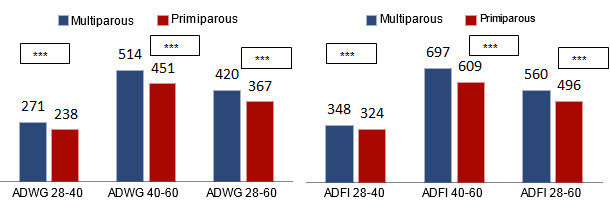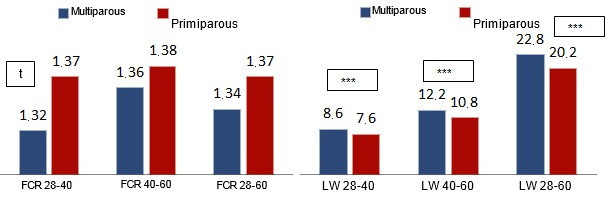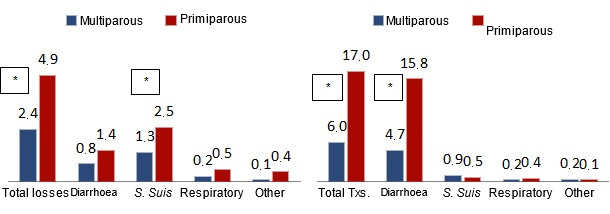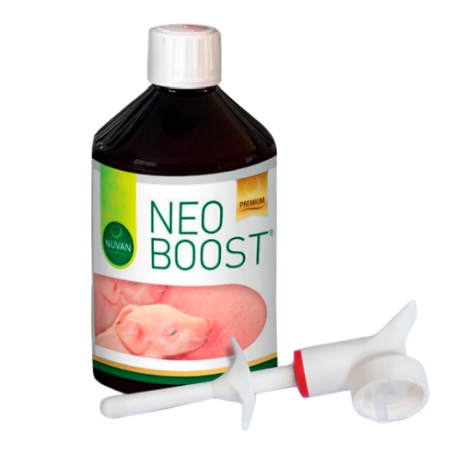In the two previous articles we have seen the factors that have an influence on the presence of small piglets and piglets with a lower viability, partly because they are born to primiparous sows. The lower body weight and the consumption of a lower amount of colostrum with a reduced concentration of IgGs (Cabrera et al., 2012) explain the higher risks for these piglets. But, how do these piglets perform under commercial conditions? In PigCHAMP we have worked to quantify this effect under commercial conditions and to be able to define its application in practice.
In 5 experimental tests we recorded, separately, the results in the nursery stage of piglets born to primiparous and multiparous sows. In total, 2,660 piglets (1,740 born to multiparous sows and 920 born to primiparous sows) were controlled to study the effect on the production parameters (growth, feed conversion rate and feed consumption), the percentage of losses and the percentage of animals treated individually. In each test, the performance of the animals born to primiparous and multiparous sows and that shared the same space and that were distributed randomly in pens with the same surface were compared. The pen was the experimental unit for the consumption of feed and the feed conversion rate.

Production performance
Graphs 1 to 4 show the production and health results of the piglets in the nursery stage according to their origin.
Graphs 1 and 2. Average daily weight gain (ADWG) (g/d) and average daily feed intake (ADFI) (g/d) in the nursery stage according to the origin of the piglets (primiparous or multiparous sows).

Graphs 3 and 4. Feed conversion rate (FCR) (g/g) and liveweight (LW) (kg) in the nursery stage according to the origin of the piglets (primiparous or multiparous sows)

Probability; NS, P > 0.10; t, P < 0.10; ***, P < 0.001
The animals born to primiparous sows grew less (-14 %), mainly due to a lower feed intake (-13 %) and to a lower feed conversion efficiency (-2 %), that caused a difference in liveweight of 2.6 kg at the end of this period (-13 %).
On the other hand, the health results were consistent with the previous results, because both the percentage of losses and the number of treated animals were significantly lower in the case of the piglets born to multiparous sows.
Graphs 5 and 6. Total losses (%), treated animals (%) and their distribution according to their origin (primiparous or multiparous sows).


Probability; NS, P > 0.10; t, P < 0.10; *, P < 0.05
The piglets born to primiparous sows showed a mortality that doubled that of the piglets born to multiparous sows and needed almost three times more treatments, especially against diarrhoea.
We can reach the conclusion that the piglets with a low weight and that are also born to primiparous sows will also show a worse performance and a risk of dying that will double approximately that of the piglets born to multiparous sows, and also a higher need for treatments (up to 3 times more) against some diseases. The implications of this situation are noticeable, and its control can be approached from two standpoints:
- Sale / segregation of the piglets born to primiparous sows. It is recommendable if there is a production excess with respect to the needs of the farm or if there are pathologic problems that are difficult or expensive to control with the traditional means.
- Segregated rearing of the piglets born to primiparous sows: it will facilitate the control of their risks promoting, at the discretion of the veterinarian, specific health plans (vaccinations or treatments with drugs) for them, with the resulting savings for the farm. This option is more difficult in small or family farms, but a certain degree of distance (e.g. pens exclusive for them), although it is not completely achieved, will always facilitate the control of the problems.
Although there is still much applied research needed to define better the alternatives for controlling these effects, bearing in mind this effect in the production routines can help to improve the competitiveness of the industry, because it is important enough to consider its routine implementation.




